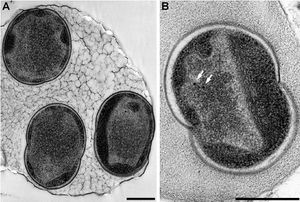Microthrix: Difference between revisions
From MicrobeWiki, the student-edited microbiology resource
| Line 11: | Line 11: | ||
=Description= | =Description= | ||
Microthrix bacteria are one of the many bacterial genera found within activated sludge in wastewater treatment plants (WWTT's). In fact, certain species Microthrix parvicella have only be detected in the activated sludge of WWTPs. Some other species of Microthrix are found in marine environments and sediments. These bacteria are primarily responsible for some of the difficulty in separating the liquid and solid phases during activated sludge circulation. Their filamentous morphology causes bulk increases and material foaming that makes solid-liquid separation a bit difficult. | |||
Microthrix are very long, thin cells with diameters not not exceeding .8 micrometers. They are easily identified under a light microscope because of their characteristic morphology and coiled appearance. They are gram-positive and are able to be grown in isolated culture. | |||
[[File:alcanivorax bork.jpg|300px|thumb|right|Alcanivorax borkumensis [1F] ]] | [[File:alcanivorax bork.jpg|300px|thumb|right|Alcanivorax borkumensis [1F] ]] | ||
Revision as of 13:46, 13 May 2015
Classification
Domain: Bacteria Phylum: Actinobacteria Class: Actinobacteria Order: Actinomycetales Family: Genus: Microthrix Species:
Description
Microthrix bacteria are one of the many bacterial genera found within activated sludge in wastewater treatment plants (WWTT's). In fact, certain species Microthrix parvicella have only be detected in the activated sludge of WWTPs. Some other species of Microthrix are found in marine environments and sediments. These bacteria are primarily responsible for some of the difficulty in separating the liquid and solid phases during activated sludge circulation. Their filamentous morphology causes bulk increases and material foaming that makes solid-liquid separation a bit difficult.
Microthrix are very long, thin cells with diameters not not exceeding .8 micrometers. They are easily identified under a light microscope because of their characteristic morphology and coiled appearance. They are gram-positive and are able to be grown in isolated culture.
Ecology and Significance
Genome Structure
Metabolism
References
[1] Golyshin, Peter N. “Genome Sequence Completed of Alcanivorax borkumensis, a Hydrocarbon-degrading Bacterium That Plays a Global Role in Oil Removal from Marine Systems.” 3 (2003): 215-20. Print.
Figures
[1F]
[1] [2F] [2] [3F] [3] [4F] [4] [5F] [Original Figure. Author: Pawan Dhaliwal] [6F]
http://microbewiki.kenyon.edu/index.php/File:Lorenzo.gif
[7F] [5]
Author
Page authored by _____, student of Prof. Katherine Mcmahon at University of Wisconsin - Madison.

